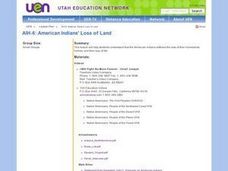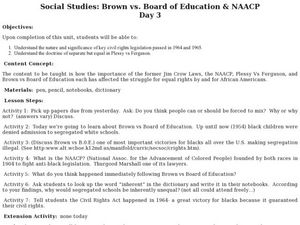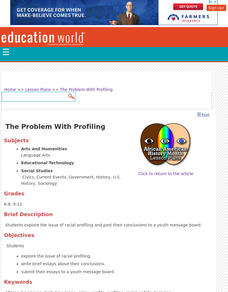Curated OER
Systems of Power Against and Within American Indian Communities, 1880-1940
High schoolers explore methods and the struggles of power between the federal policies and Native populations. They discuss the issue of controlling the Native Indian population, driving them from their land, and providing a mandatory...
Curated OER
American Indians' Loss of Gold
Fifth graders examine and discuss how the American Indians suffered the loss of their homelands, homes, and their way of life. They watch videos, read books and develop research projects on the struggles of the American Indians.
Curated OER
Checks and Balances: Japanese-American Incarceration
Students examine the three branches of the Federal Government and their decision to place Japanese-Americans in camps during World War II. They analyze debates made by leaders during this time period.
Curated OER
California Trail and Native Americans
Fifth graders identify the American Indian tribes who lived on the lands in which the California Trail went through. They investigate and describe the impact of western expansion on the American Indians.
Curated OER
Heritage: Legends, Fairy Tales and the Native Americans
Fourth graders compare and contrast a Native American legend with a fairy tale and share their ideas by creating a venn diagram.
Curated OER
Heritage: Legends, Fairy Tales and the Native Americans
Fourth graders read a Native American legend local to the Utah region and compare it to a traditional European fairy tale. They use a Venn diagram as a graphic organizer for the comparison.
Curated OER
Native American Images in the Media
Students examine various images of Native Americans in the media. In groups, they create a list of present Native American stereotypes and what the media did to continue the stereotype. To end the lesson, they write in their journals...
Curated OER
Common Sense Lesson Plan
Students examine excerpts of "Common Sense" and determine how it influenced the times. Using other primary source documents, they identify the amount of political discourse before and during the American Revolution. They answer questions...
Curated OER
Brown vs. Board of Education and NAACP
Eleventh graders examine the issues surrounding Brown vs. Board of Education. In this American Government lesson, 11th graders study the key civil rights legislation passed in 1964 and 1965.
National Endowment for the Humanities
Colonizing the Bay
Eleventh graders review the goals of John Winthrop. In this American History lesson, 11th graders read Winthrop's speech and summarize his key points. Students predict the possibilities for success and failure in the...
Curated OER
Budget Debate: How Would You Balance the Federal Budget?
Learners examine how to balance the federal budget. In this American economics lesson, students read the provided article "Congress Debates Cutting the Budget." Learners then collaborate in small groups to determine how to balance the...
George Washington's Mount Vernon Estate & Gardens
George Washington: Centerpiece of a Nation
A neat Presidents Day activity, this lesson provides a culminating learning experience for upper elementary aged learners. After analyzing George Washington's, "A Display of the United States of America," your learners will conduct...
Curated OER
The Federalist Debates: Balancing Power Between State and Federal Governments
Students examine the pros and cons of state sovereignty vs. federalism, as argued by the Founding Fathers. They identify the basic positions of each side, complete a worksheet, and write a persuasive essay arguing for Jefferson or Hamilton.
National Constitution Center
Born in the U.S.A: Music as Political Protest
Though often used in shows of patriotism, Bruce Springsteen's 1985 song "Born in the U.S.A." is critical of America's role in the Vietnam war and its treatment of American veterans. High schoolers analyze the song's lyrics in an activity...
Friends of Fort McHenry
Privateers in the War of 1812: Soldiers or Thieves?
Do governments have the right to authorize individuals to perform illegal acts during times of war? Did the US government really employ pirates? Use the War of 1812 as your vessel to answering these questions through class discussion and...
Curated OER
Photography and the National Park Service
During the 1800s the United States was expanding westward; land was there for the taking. Kids explore how some early photographers used their photography to influenced the US Congress to save areas like Mirror Lake. They...
C-SPAN
What Are Ways for Youth to Engage in Politics?
Help young people become excited to participate in politics. High school historians participate in an engaging lesson focused on ways for youth to become involved in government. Scholars review articles, videos, and essential vocabulary...
Benjamin Franklin Tercentenary
Benjamin Franklin, Elder Statesman
Ben Franklin was the only American to sign The Declaration of Independence, the Treaty of Alliance with France, the Treaty of Paris, and the US Constitution. An interesting resource explores his role in the latter by comparing the US...
Constitutional Rights Foundation
270 Votes to Win: The Electoral College in the United States
What exactly is the Electoral College and how does it work? The lesson plan is part of a larger series on government that explains what the Electoral College is and how it helps determine an election winner. Academics participate in...
Constitutional Rights Foundation
Winner-Take-All: The Two-Party System
Two's company, three's a crowd. High school historians learn about the Electoral College, a two-party, winner-take-all voting system in the United States. The lesson explains the pros and cons of the two-party system, roadblocks for...
Curated OER
Globalization and Consumerism
Is the expansion of American corporations abroad a good or bad thing? After examining the global operations of Ford Motor Company, McDonald's, and Walmart, class members are asked to evaluate the impact of globalization and...
Curated OER
The Problem with Profiling
Students explore the issue of racial profiling and post their conclusions to a youth message board. They research the issue of racial profiling and post their thoughts to a message board.
Scholastic
What Makes a Leader?
After creating a list of great American leaders from the last century and researching their lives, pupils will brainstorm aspects of leadership and discuss what traits may be shared by all leaders.
Roy Rosenzweig Center for History and New Media
Founding Documents
Teach the class about the predecessor to Declaration of Independence—the Virginia Declaration of Rights. Using the foundational documents, scholars examine the two writings to consider how they are similar and how they are different. A...























